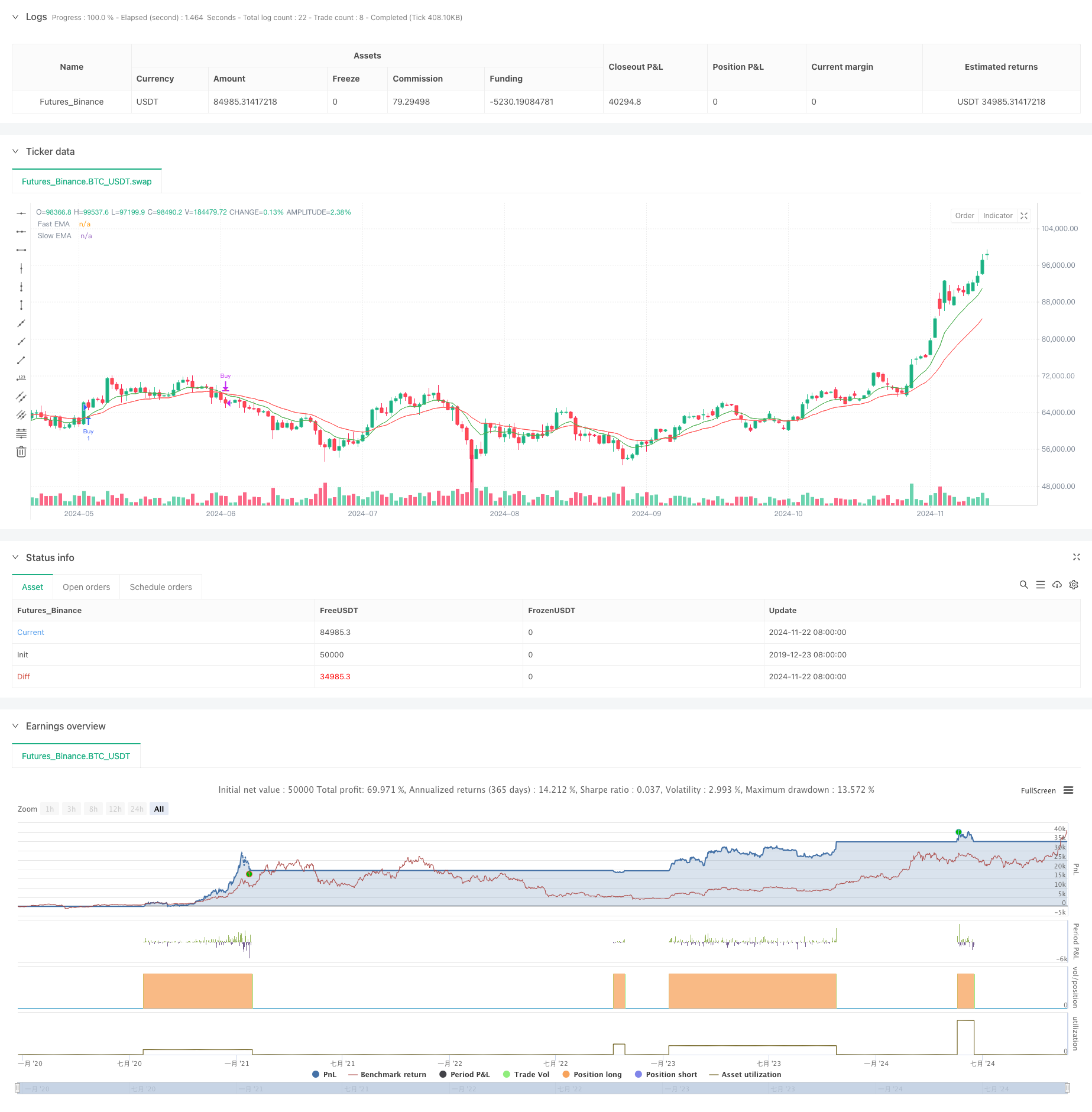
概述
该策略是一个结合了移动均线、相对强弱指标和趋势强度指标的综合交易系统。通过多重技术指标的协同配合,实现了对市场趋势的精确捕捉和风险的有效控制。系统采用了动态的止盈止损机制,确保了交易的风险收益比,同时通过指标参数的灵活调整来适应不同市场环境。
策略原理
策略主要基于三个核心指标:快速和慢速指数移动平均线(EMA)、相对强弱指标(RSI)和平均趋向指标(ADX)。当快速EMA上穿慢速EMA时,系统会检查RSI是否处于非超买区域(低于60),同时确认ADX显示趋势强度充分(大于15)。满足这些条件时,系统会发出做多信号。相反的条件组合则触发平仓信号。系统还设置了基于风险收益比的动态止盈止损点,通过参数化的方式实现对交易风险的精确控制。
策略优势
- 多重技术指标的协同确认提高了交易信号的可靠性
- 动态的止盈止损机制确保了每笔交易的风险可控
- 参数化的设计使策略具有较强的适应性
- 趋势强度确认机制有效降低了假突破带来的风险
- 系统自带警报功能,便于实时监控市场机会
策略风险
- 多重指标条件可能导致错过一些交易机会
- 在震荡市场中可能频繁产生虚假信号
- 固定的风险收益比可能不适合所有市场环境
- 参数优化过度可能导致过拟合问题
策略优化方向
- 引入自适应的参数调整机制,使系统能够根据市场波动性动态调整指标参数
- 增加成交量指标作为辅助确认信号
- 开发动态的风险收益比调整机制,根据市场环境自动调整止盈止损比例
- 加入市场波动率过滤机制,在高波动率环境下调整策略激进程度
- 考虑增加时间过滤器,避免在不利的交易时段进行操作
总结
该策略通过多重技术指标的综合运用,建立了一个相对完整的交易系统。其核心优势在于通过指标协同配合提高了交易信号的可靠性,同时通过动态的风险控制机制保障了交易的安全性。虽然存在一些固有的局限性,但通过建议的优化方向,策略仍有较大的改进空间。整体而言,这是一个具有实用价值的交易策略框架,适合进一步优化和实战应用。
策略源码
/*backtest
start: 2019-12-23 08:00:00
end: 2024-11-23 08:00:00
period: 1d
basePeriod: 1d
exchanges: [{"eid":"Futures_Binance","currency":"BTC_USDT"}]
*/
//@version=5
strategy("Enhanced EMA + RSI + ADX Strategy (Focused on 70% Win Rate)", overlay=true)
// Input parameters
lenFast = input.int(9, title="Fast EMA Length", minval=1)
lenSlow = input.int(21, title="Slow EMA Length", minval=1)
rsiPeriod = input.int(14, title="RSI Period")
adxPeriod = input.int(14, title="ADX Period")
adxSmoothing = input.int(1, title="ADX Smoothing")
adxThreshold = input.int(15, title="ADX Threshold")
riskRewardRatio = input.float(1.5, title="Risk/Reward Ratio")
rsiOverbought = input.int(60, title="RSI Overbought Level") // Adjusted for flexibility
rsiOversold = input.int(40, title="RSI Oversold Level")
// EMA Calculations
fastEMA = ta.ema(close, lenFast)
slowEMA = ta.ema(close, lenSlow)
// RSI Calculation
rsiValue = ta.rsi(close, rsiPeriod)
// ADX Calculation
[plusDI, minusDI, adxValue] = ta.dmi(adxPeriod, adxSmoothing)
// Entry Conditions with Confirmation
buyCondition = ta.crossover(fastEMA, slowEMA) and rsiValue < rsiOverbought and adxValue > adxThreshold
sellCondition = ta.crossunder(fastEMA, slowEMA) and rsiValue > rsiOversold and adxValue > adxThreshold
// Dynamic Exit Conditions
takeProfit = strategy.position_avg_price + (close - strategy.position_avg_price) * riskRewardRatio
stopLoss = strategy.position_avg_price - (close - strategy.position_avg_price)
// Entry logic
if (buyCondition)
strategy.entry("Buy", strategy.long)
strategy.exit("Sell", from_entry="Buy", limit=takeProfit, stop=stopLoss)
if (sellCondition)
strategy.close("Buy")
// Plotting EMAs
plot(fastEMA, color=color.new(color.green, 0), title="Fast EMA", linewidth=1)
plot(slowEMA, color=color.new(color.red, 0), title="Slow EMA", linewidth=1)
// Entry and exit markers
plotshape(series=buyCondition, style=shape.triangleup, location=location.belowbar, color=color.new(color.green, 0), size=size.normal, title="Buy Signal")
plotshape(series=sellCondition, style=shape.triangledown, location=location.abovebar, color=color.new(color.red, 0), size=size.normal, title="Sell Signal")
// Alerts
alertcondition(buyCondition, title="Buy Alert", message="Buy signal triggered")
alertcondition(sellCondition, title="Sell Alert", message="Sell signal triggered")
相关推荐